On a recent journey to Malta, I decided to skip sightseeing for a day and immerse myself in a literary walk. The books of Thomas Pynchon had a significant impact on me, and it seemed only fair to dedicate a day to the writer. Some of the best pages of Pynchon’s “V” -his debut novel- are set in Valletta, and I thought of searching for locations portrayed in the book. Therefore, “what’s left from Thomas Pynchon’s “V.” in Valletta?” is an attempt to see if the novel’s pages are still alive in Malta.
Apparently, this was a challenging task. “V.” was published almost sixty years ago, in 1963. That said, many streets have different names nowadays, street numbering has changed, and, of course, things have changed anyway in the capital of Malta. Moreover, Pynchon’s unique way of mixing facts and fiction to create alternate realities meant that it wouldn’t be easy to locate everything. Nonetheless, I thought it deserved to try, and here you’ll see a photo report from the locations mentioned in the book.
If you’re not a Thomas Pynchon fan, you’ll find info about the writer and his books at the bottom of this post.
So, let’s see what’s left from Thomas Pynchon’s “V.” in Valletta.
*Some links are affiliate links. It means that if you buy something, I might earn a small commission at no additional cost to you.
What’s left from Thomas Pynchon’s “V.” in Valletta

“V.” is a complex novel featuring a vast number of characters and locations. Among the protagonists is a man from England called Herbert Stencil. Stencil appears to be obsessed with “V.” and her identity. The woman is mentioned in his father’s journal, who mysteriously disappeared in the June 1919 riots in Malta. Stencil, who always talks in the third person, is searching for his father and the mysterious “V.”
There’s a lot of speculation if Pynchon traveled to Malta or not. However, the accuracy of his descriptions is so impressive that it’s fair to assume that Pynchon was at least once on the island. According to Arnold Cassola (more on the “Sources” section) and his article about the writer and his Malta connection, “it could not have been just the fruit of his imagination.”
So, in the following sections, you’ll see some Valletta locations accompanied by quotes from “V.” Regarding page numbers, I used an older edition of “V.” by Random House; if you have a different edition, please search in the book’s respective chapters. Most editions have 492 pages -that’s the case with my copy too. Hence, the page numbers mentioned in this article are accurate only for the 492-pages copies.
Phoenicia Hotel (“V.” Chapter Sixteen)
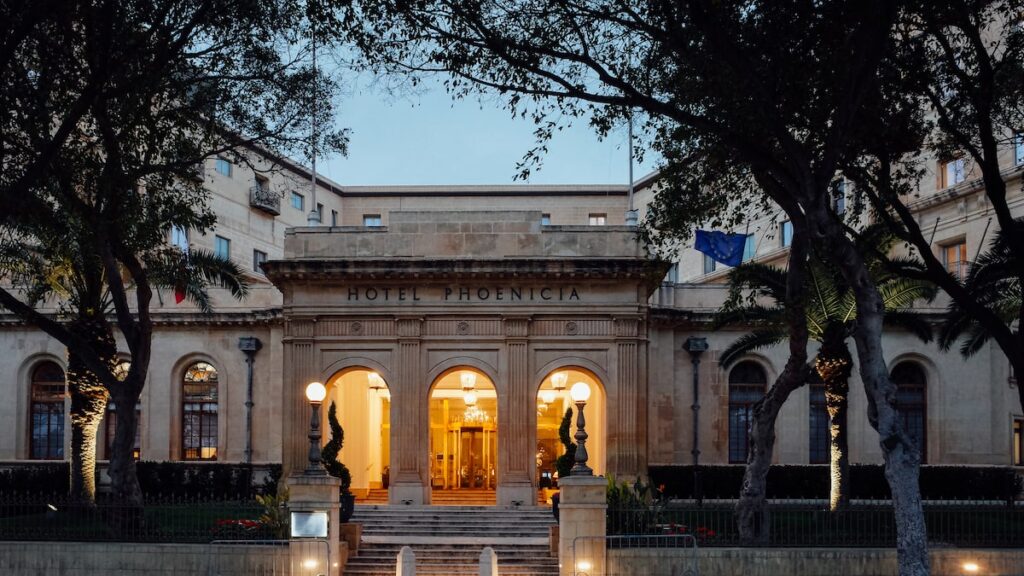
In the first pages of Chapter 16, on page 428, two sailors get off the bus in Floriana, an area straight outside the Valletta walls. That’s still one of the biggest bus terminals in Malta and the place where most Valletta buses depart.
The two sailors, Pappy and Fat Clyde, disembark in front of the Phoenicia Hotel. Although it dates back to 1947, the Phoenicia Hotel still exists, and it’s one of the most luxurious hotels in Malta. Its name, Phoenicia, it’s probably a tribute to the palm trees on the road in front of the entrance.
Pynchon writes in the book: “They pulled up to the Phoenicia Hotel at last: smoke still leaking from the windows. Night had fallen. Raucous with song, the men of the Scaffold boat descended on Valletta.”
And in the next paragraph, he adds another sentence about the hotel: “Palm leaves in front of the hotel chattered in the wind.”
Kingsgate, Valletta (“V.” Chapter Sixteen)
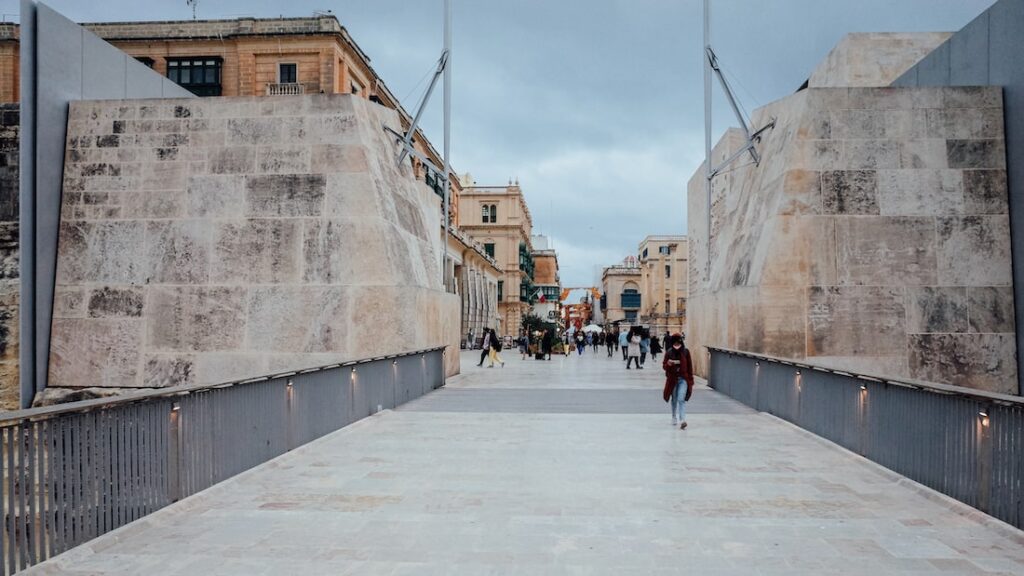
On the same page (428) of Chapter 16, Thomas Pynchon gives another fleeting impression of Malta. Since he is more interested in developing the plot, he only adds one line. He writes: “They walked under an arch and into Kingsway.” The arch Pynchon refers to is the City Gate. A couple of meters away from Phoenicia Hotel and past the Triton fountain, you’ll see the Valletta Walls. The “arch” is the gate you’ll have to walk through to enter Valletta.
City Gates seemed to have a long history in Malta. The one you see today is pretty recent: it dates back to 2011-2014, designed by Renzo Piano. However, the first gate was the Porta San Giorgio (1569). The gate was rebuilt in 1633 (second gate) and replaced in 1853 (third gate). The third gate stood until 1964, just a year after V’s publication, and was called Kingsgate. That’s the one in Pynchon’s novel, and, obviously, it doesn’t exist anymore.
Kingsway, Valletta (“V.” Chapter Sixteen)
As for Kingsway, that’s the name of the street straight after the City Gate. Kingsway is now called Republic Street. Pynchon writes: “Kingsway seethed. There was this sense of containment, like a sound stage.”
And a couple of lines later, on page 429, he continues: “On some street corners trinket-stalls were set up, and doing a peak trade in good-luck charms and Maltese lace.” However, the trinket stalls he describes don’t exist anymore.
In general, Republic Street is one of Valletta’s main streets. However, the name’s replacement (from Kingsway to Republic) meant subsequent changes in the street numbers. That said, it was hard to locate some places in Thomas Pynchon’s “V.”
Philips Radio Store (“V.” Chapter 16)
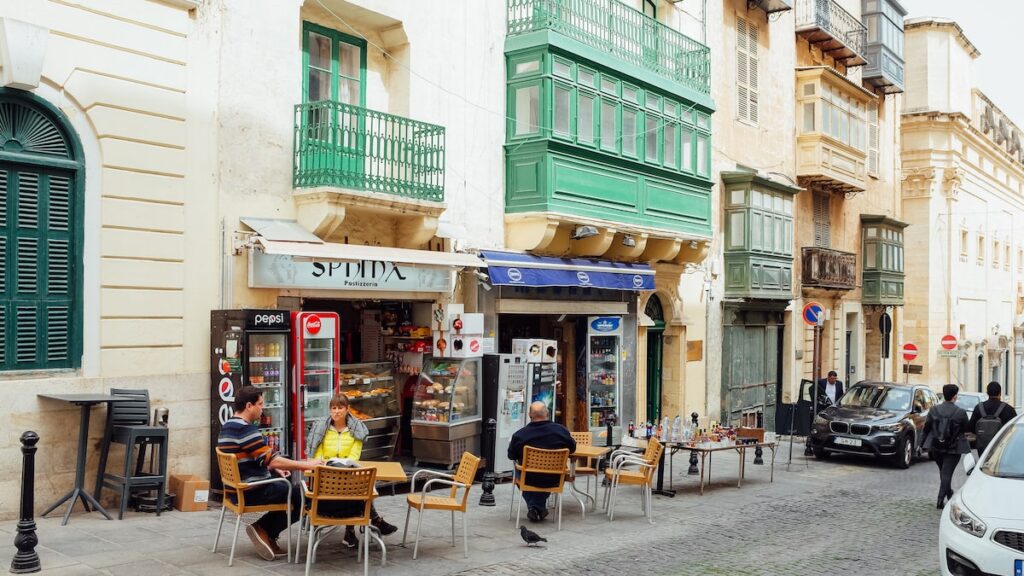
Unfortunately, I couldn’t spot the Philips radio store mentioned on page 429. Pynchon writes: “From a Philips radio store to their left, news broadcasts were going full blast.” According to Cassola’s article, the store still exists. However, I couldn’t locate it. It might have been a recent change of use, but on 282 Republic Street, I saw a small pastizzeria (a place where you can buy traditional Maltese pastizzi). But anyway, as you see in the photo, that’s how the place looks today.
Newspaper kiosk (“V.” Chapter Sixteen)
I couldn’t locate the newspaper kiosk either. Supposedly, there was one on 46 Republic Street, selling the Times of Malta. It probably doesn’t exist anymore. On the other hand, the Times of Malta still operates.
Pynchon’s line on page 429 is: “Nearby at a newspaper kiosk, red scare headlines proclaimed British intend to move into Suez.”
The four aces (“V.” Chapter Sixteen)
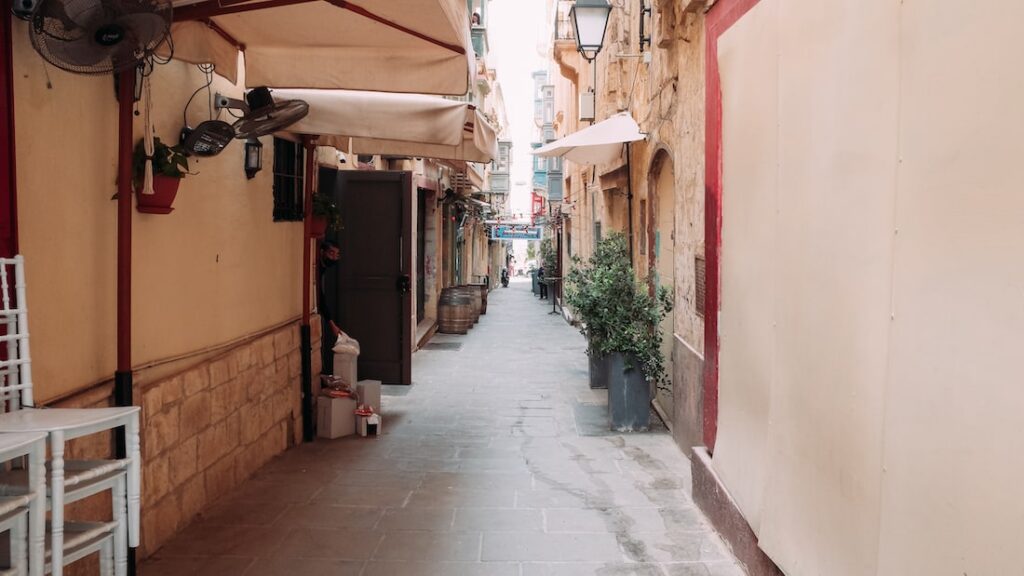
Pappy and Clyde visit a couple of obscure places while walking around Valletta. Most of them are located on Strait Street, also known as The Gut. The area around The Gut was the red light district of Malta, frequented by servicemen.
The first place the two sailors visit is “The Four Aces.” It was on 138 Strait Street and shut down many years ago.
Pynchon writes on page 430: “They entered the Four Aces. It was early yet and no one but a few low-tolerance drunks like Leman were causing any commotion. They sat at a table. “Guinness stout,” said Pappy and the words fell on Clyde like a nostalgic sandbag.”
The Union Jack (“V.” Chapter 16)
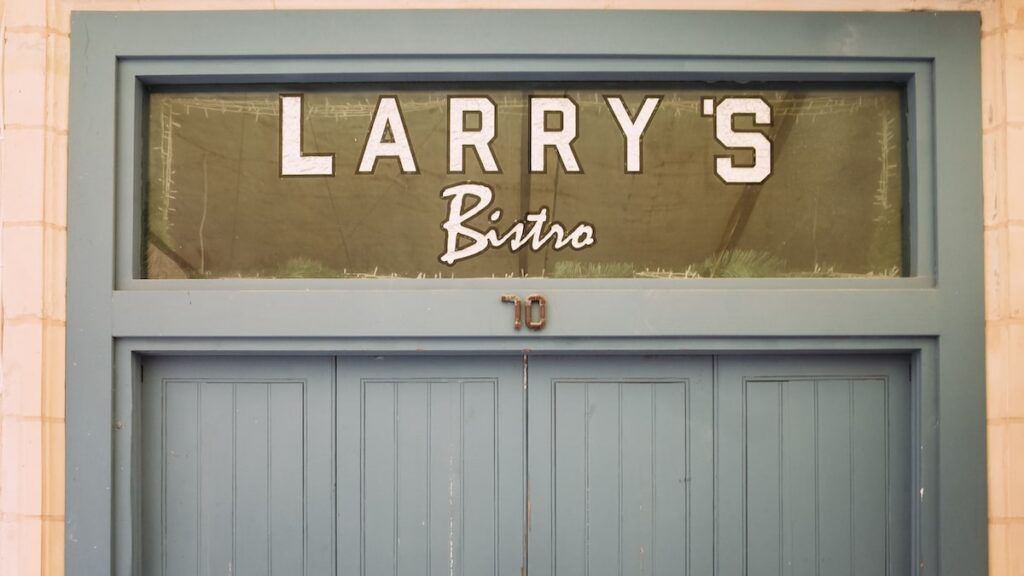
Not that far away from the Four Aces, Clyde visits another bar. Its name is “The Union Jack.” I could locate the building, but the bar was long gone too. You can find it at 70 Strait Street. There’s not much description in the book (page 433), but there’s a dialogue between Clyde and Antoine Zippo.
The Metro (Chapter 16)
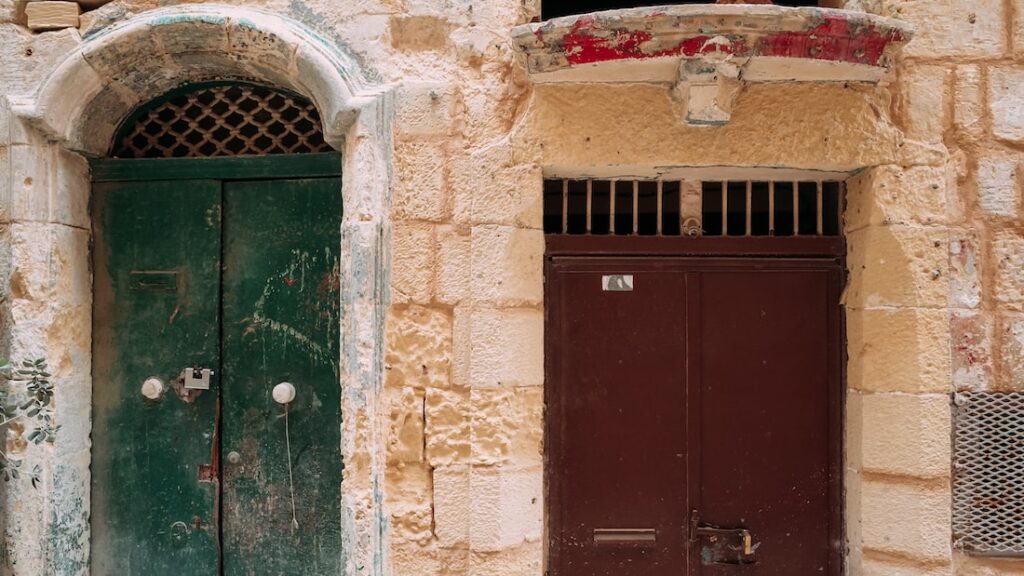
“The Metro” is the favorite hangout of Pappy. Once located at 122 Strait Street, the bar doesn’t exist anymore.
On page 437, Pynchon writes: “The Metro looked like a nobleman’s pied-a-terre applied to mean purposes. The dancing floor and bar lay up a wide curving flight of marble steps lined with statues in niches: statues of Knights, ladies and Turks.”
John Bull Bar (“V.” Epilogue)

I had more luck with the location of the John Bull Bar mentioned in the epilogue. It seems that there’s a bar at the corner of Republic Street and St Nicholas Street; however, it’s not under the same name. I’m unsure if that’s the correct location, but in the corner of these streets, that’s the only spot with the potential to be the one.
In Pynchon’s words on page 469: “Maijstral is going to the John Bull,” said the pope. “We can catch up with him later.”
Vittoriosa (or Birgu), one of the Three Cities, (“V.” Epilogue)

That’s a more generic passage from “V.” and, at the same time, one of Malta’s iconic locations. The Three Cities -Vittoriosa, Senglea, and Cospicua- are at a short distance from Valletta. One can reach them by boat (15 minutes ride), and they are visible from Valletta’s Grand Harbor.
Pynchon describes on pages 456-457: “His cheeks hollowed and flattened as the xebec seemed to describe a complete circle and Grandmaster La Vallette’s dream whirled away for Fort St. Elmo and the Mediterranean, which in their turn spun past into Ricasoli, Vittoriosa, the Dockyard.”
And on page 456, Pynchon also briefly describes Fort St. Angelo, the Knights’ headquarters during the Great Siege of Malta of 1565: “Overhead for a while hung Fort St. Angelo, dirty yellow and wrapped in a quiet not of this earth.”
The great lift (“V.” Chapter 16)
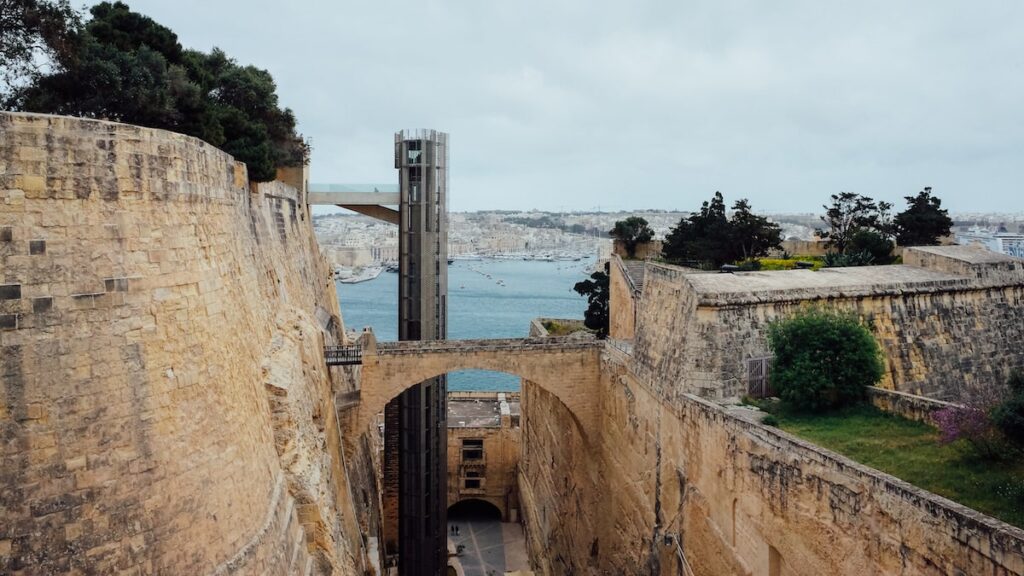
Finally, there’s a mention of the great lift on page 454. The great lift refers to an urban shortcut. Nowadays, its name is Barrakka Lift, but in former times there was another lift at the same spot. Specifically, it operated between 1905 and 1973 until it was demolished in 1983. The lift connects Lascaris Wharf to St. Peter and Paul Bastion at the Upper Barrakka Gardens. Why’s that an urban shortcut? Well, it’s because it connects in 23 seconds the Grand Harbor and the city. If you had to walk, it’d take approximately 20 minutes.
Pynchon mentions the great lift in a dialogue on page 454. He writes: “I write poetry,” she announced. They were at her place, a modest hotel near the great lift.”
Thomas Pynchon’s “V.” in Valletta: Sources I used

Apart from rereading the book, I also got great help from online sources.
Specifically, I got help from the Pynchon Wiki about the book, which helped me navigate the sections quickly. Some of the book quotes are directly from the Wiki, while others I copied from the book.
Also, a great resource was the article written by Arnold Cassola. It is an in-depth essay about the whereabouts of Thomas Pynchon in Valletta. Without this article, I wouldn’t have the chance the locate the (nowadays) lost places mentioned in the book. If you’re interested, you can read Arnold Cassola’s essay here.
Thomas Pynchon: bio & books
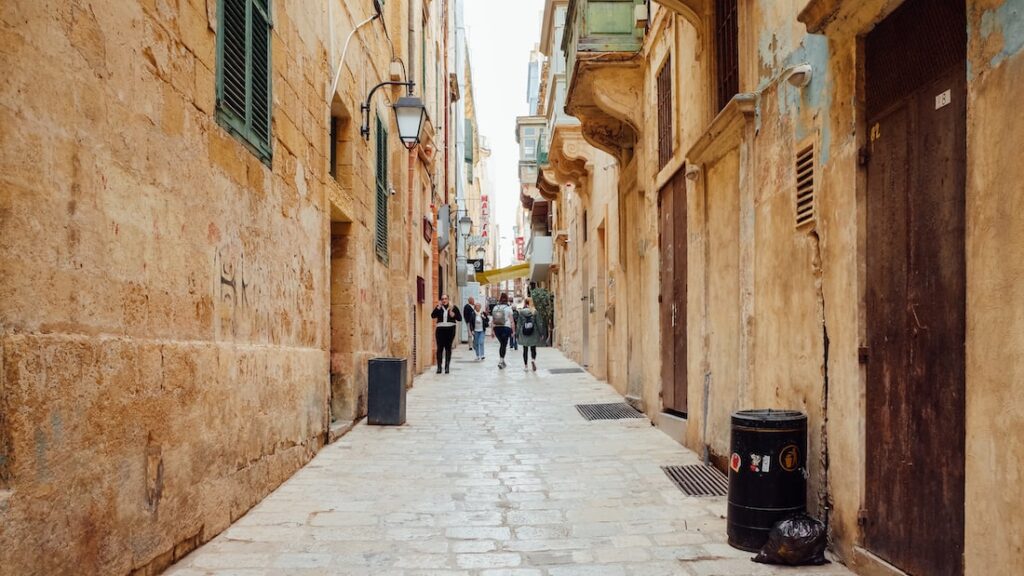
Thomas Ruggles Pynchon Jr. (1937) is an American novelist famous for his complex novels. His writing combines various genres and themes, including history, science, music, and mathematics. He served two years in the United States Navy (and maybe that’s when he traveled to Malta). Pynchon never appeared in public events and has only been photographed once or twice more than 50 years ago.
Thomas Pynchon has written nine books. These are:
- V. (1963)
- The Crying of Lot 49 (1966)
- Gravity’s Rainbow (1973)
- Slow Learner (1984)
- Vineland (1990)
- Mason & Dixon (1997)
- Against the Day (2006)
- Inherent Vice (2009)
- Bleeding Edge (2013)
I hope you enjoyed this article about Thomas Pynchon and V‘s locations in Valletta. Please let me know in the comments if I forgot something -well, I probably missed a lot– and if other Malta locations deserve to be in this article.
More literature: Franz Kafka in Prague, The Bleibtreustrasse in Berlin
Pin it for later

Sharing is caring. Please share this article about Thomas Pynchon with your friends.
Last Updated on August 27, 2022 by George Pavlopoulos


George, when I think of V, I think of the science fiction TV series or even the film V for Vendetta. Now that I know you’ve read V, I wonder whether you have read Ulysses by James Joyce. If you have, I will be very impressed. Would it be a book that would interest you?
John, I’m a big fan of Vs! I liked the sci-fi series very much, and the same goes for V for Vendetta (there’s also a Pynchon reference in it). Yes, I’ve read most of James Joyce’s books, Ulysses included. A challenging book, but I still haven’t participated in a Bloomsday. A James Joyce literary walk is in my plans, and I hope to make one soon.
Do you like Pynchon? I never thought of asking you so far.
Pynchon and Joyce are way too advanced for me. I’m more in the 15-year-old reading age bracket. You must have read many novels to have read books from both of these famous authors. Plus, I know you have written your own novel, which is a significant accomplishment. When I interview you for my website, I’ll have to ask you questions about your reading regime and some of the best books you’ve read.
Looking forward to that interview, John 🙂
I always tried to read as much as possible. Despite having less free time lately, I still try to read 30-40 pages per day; a novel, a history book, it doesn’t matter. I just need to touch an analog book. Pynchon was always a great inspiration and one of the most original writers I have ever come across. His books aren’t easy and definitely not pageturners. However, the universe he creates is unique, and I’m always up for some Pynchon pages. Rereading “V.” before visiting Valletta reminded me why I appreciate him so much.
George,
Thank you for posting this. I was wondering the same thing about Valletta and that’s what led me to this page.
Hey Larry,
Glad you found this small report helpful. There are a few Thomas Pynchon things left in Valletta for sure. And having read V., it was touching to see the locations. Most buildings are probably long gone, but there’s a Pynchon-esque atmosphere still in town.
All the best,
George